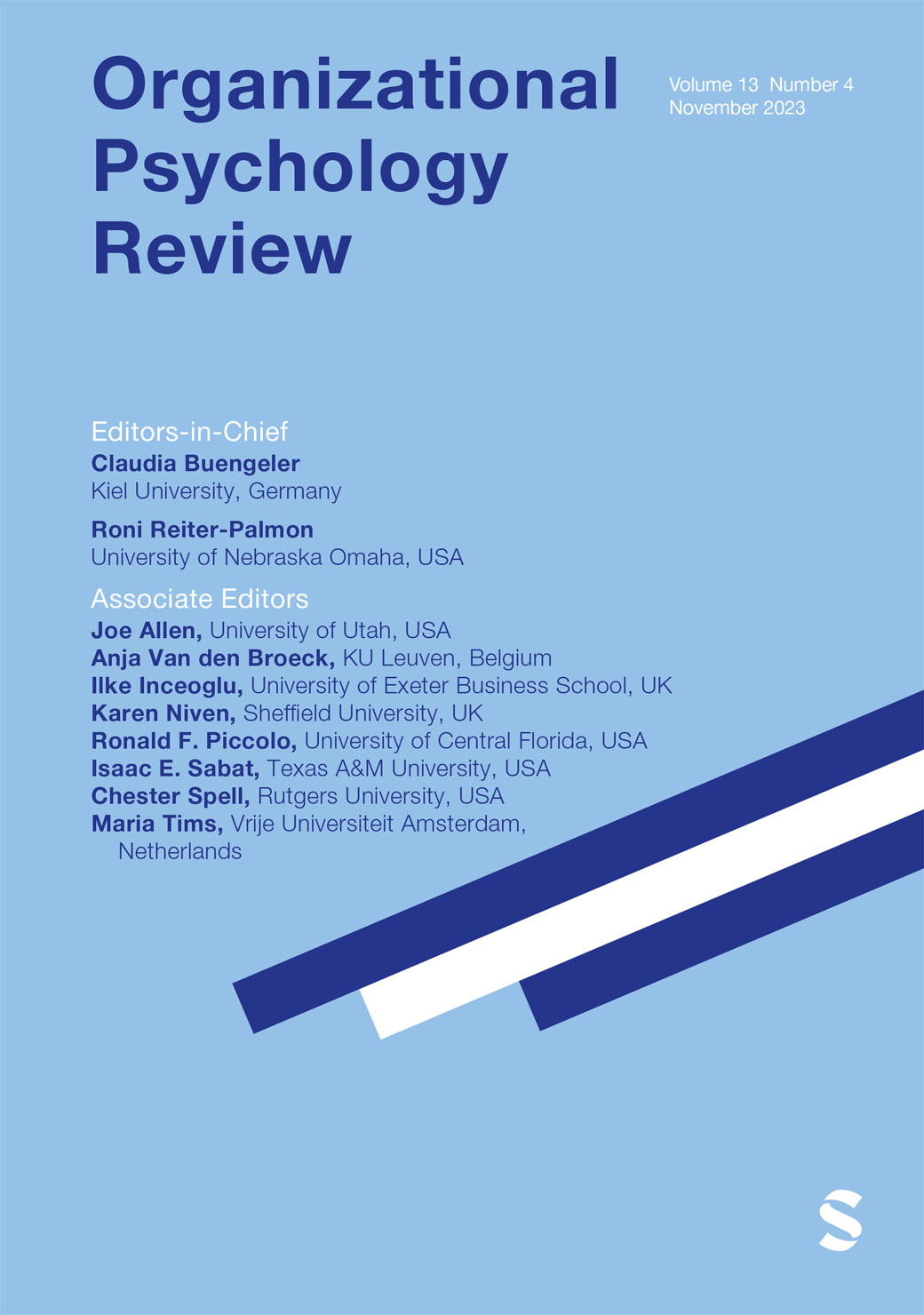The team cohesion-performance relationship: A meta-analysis exploring measurement approaches and the changing team landscape
IF 7.1
1区 心理学
Q2 MANAGEMENT
引用次数: 21
Abstract
Team cohesion is an important antecedent of team performance, but our understanding of this relationship is mired by inconsistencies in how cohesion has been conceptualized and measured. The nature of teams is also changing, and the effect of this change is unclear. By meta-analyzing the cohesion-performance relationship (k = 195, n = 12,023), examining measurement moderators, and distinguishing modern and traditional team characteristics, we uncovered various insights. First, the cohesion-performance relationship varies based on degree of proximity. More proximal measures –task cohesion, referent-shift, and behaviorally-focused– show stronger relationships compared to social cohesion, direct consensus, and attitudinally-focused, which are more distal. Differences are more pronounced when performance metrics are also distal. Second, group pride is more predictive than expected. Third, the cohesion-performance relationship and predictive capacity of different measures are changing in modern contexts, but findings pertaining to optimal measurement approaches largely generalized. Lastly, important nuances across modern characteristics warrant attention in research and practice. Plain Language Summary Team cohesion is an important antecedent of team performance, but our understanding of this relationship is mired by inconsistencies in how cohesion has been conceptualized and measured. The nature of teams has also changed over time, and the effect of this change is unclear. By meta-analyzing the cohesion-performance relationship (k = 195, n = 12,023), examining measurement moderators, and distinguishing between modern and traditional team characteristics, we uncovered various insights for both research and practice. First, the cohesion-performance relationship varies based on degree of proximity. Measures that are more proximal to what a team does – those assessing task cohesion, utilizing referent shift items, and capturing behavioral manifestations of cohesion – show stronger relationships with performance compared to those assessing social cohesion, utilizing direct consensus items, and capturing attitudinal manifestations of cohesion, which are more distal. These differences are more pronounced when performance metrics are also more distal. Second, despite being understudied, the group pride-performance relationship was stronger than expected. Third, modern team characteristics are changing both the overall cohesion-performance relationship and the predictive capacity of different measurement approaches, but findings pertaining to the most optimal measurement approaches largely generalized in that these approaches were less susceptible to the influence of modern characteristics. However, in some contexts, distal cohesion metrics are just as predictive as their more proximal counterparts. Lastly, there are important nuances across different characteristics of modern teams that warrant additional research attention and should be considered in practice. Overall, findings greatly advance science and practice pertaining to the team cohesion-performance relationship.团队凝聚力-绩效关系:一项探索测量方法和不断变化的团队格局的荟萃分析
团队凝聚力是团队绩效的重要前提,但我们对这种关系的理解因凝聚力的概念化和衡量方式不一致而陷入困境。团队的性质也在变化,这种变化的影响尚不清楚。通过元分析凝聚力-绩效关系(k=195,n=12023),考察衡量调节因素,并区分现代和传统团队特征,我们发现了各种见解。首先,凝聚力-绩效关系因接近程度而异。与社会凝聚力、直接共识和以态度为中心相比,更接近的衡量标准——任务凝聚力、指涉物转移和以行为为中心——显示出更强的关系,而社会凝聚力和直接共识和态度为中心更为遥远。当性能指标也很遥远时,差异会更明显。其次,群体自豪感比预期更具预测性。第三,在现代背景下,不同衡量标准的凝聚力-绩效关系和预测能力正在发生变化,但与最优衡量方法有关的发现在很大程度上是普遍的。最后,现代特征之间的重要细微差别值得在研究和实践中予以关注。简明语言摘要团队凝聚力是团队绩效的重要前提,但我们对这种关系的理解因凝聚力的概念化和衡量方式不一致而陷入困境。随着时间的推移,团队的性质也发生了变化,这种变化的影响尚不清楚。通过元分析凝聚力-绩效关系(k=195,n=12023),考察衡量调节因素,并区分现代和传统团队特征,我们发现了研究和实践的各种见解。首先,凝聚力-绩效关系因接近程度而异。与评估社会凝聚力、利用直接共识项目和捕捉凝聚力的态度表现相比,更接近团队所做工作的衡量标准——评估任务凝聚力、利用参考转移项目和捕捉内聚的行为表现——显示出与绩效的更强关系,而这些衡量标准更为遥远。当性能指标也更为遥远时,这些差异会更加明显。其次,尽管研究不足,但团队自豪感与绩效的关系比预期的要牢固。第三,现代团队特征正在改变不同测量方法的整体凝聚力-绩效关系和预测能力,但与最优化测量方法有关的发现在很大程度上是普遍的,因为这些方法不太容易受到现代特征的影响。然而,在某些情况下,远端衔接指标与近端衔接指标一样具有预测性。最后,现代团队的不同特征之间存在着重要的细微差别,值得更多的研究关注,并应在实践中加以考虑。总的来说,研究结果极大地推动了与团队凝聚力-绩效关系相关的科学和实践。
本文章由计算机程序翻译,如有差异,请以英文原文为准。
求助全文
约1分钟内获得全文
求助全文
来源期刊

Organizational Psychology Review
Multiple-
CiteScore
10.00
自引率
1.60%
发文量
25
期刊介绍:
Organizational Psychology Review is a quarterly, peer-reviewed scholarly journal published by SAGE in partnership with the European Association of Work and Organizational Psychology. Organizational Psychology Review’s unique aim is to publish original conceptual work and meta-analyses in the field of organizational psychology (broadly defined to include applied psychology, industrial psychology, occupational psychology, organizational behavior, personnel psychology, and work psychology).Articles accepted for publication in Organizational Psychology Review will have the potential to have a major impact on research and practice in organizational psychology. They will offer analyses worth citing, worth following up on in primary research, and worth considering as a basis for applied managerial practice. As such, these should be contributions that move beyond straight forward reviews of the existing literature by developing new theory and insights. At the same time, however, they should be well-grounded in the state of the art and the empirical knowledge base, providing a good mix of a firm empirical and theoretical basis and exciting new ideas.
 求助内容:
求助内容: 应助结果提醒方式:
应助结果提醒方式:


